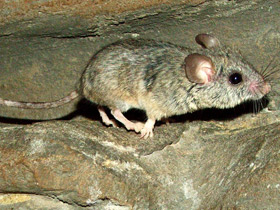The cactus mouse or cactus deermouse (Peromyscus eremicus)
Systematics, habitat, lifestyle and diet
The cactus mouse or cactus deermouse (Peromyscus eremicus) is a species of rodent in the family Cricetidae. It is a species of the genus Peromyscus, a closely related group of New World mice often called "deermice". They are native to desert areas of western North America.
Hamsters are active at night and apathetic and lethargic during the day. During the hottest and driest months they hibernate to drastically reduce their water consumption. The diet of these rodents consists of seeds, nuts, fruit, insects and other invertebrates and carrion.
Description
Cactus mice are small cricetid rodents, with large eyes and ears, a pointed snout, and a long monocolor tail. Avarage dimensions for Peromyscus eremicus are as follows: total length, 160mm to 211mm; length of body, 72mm to 100mm; length of tail, 84mm to 120mm; length of hind foot, 18mm to 22mm; length of ear, 13.4mm to 20.0mm; greatest length of skull, 22.7mm to 25.9mm and zygomatic breadth, 11.2mm to 13.5mm. Adults weigh between 18 and 40 grams (0.63 and 1.41 oz). Females weigh slightly more than males and are significantly larger in body length, ear length, length of mandible, and bullar width of skull.
Cactus mice can be identified by having naked soles on their hind feet and almost naked flesh-coloured tails (as opposed to the furry bicoloured tail common in most Peromyscus species), which are usually the same length or longer than the animals' body length. Their ears are nearly hairless, large, and membranous.
Their fur is long and soft; colouration varies between subspecies and between different populations. The colour of fur varies from ochre to cinnamon, with white ventral areas, and the sides and top of head slightly grayish. Females tend to be slightly paler in colour than males, while juveniles appear more gray than their parents.
Social behaviour and reproduction
Peromyscus eremicus can live in huge groups. They breed all year round, starting to do so from 30 to 50 days of age. In the laboratory, a female gives up to 14 litters per year. After a gestation of about 21 to 27 days, females give birth to an average of 3.4 (1 to 9) cubs. They open their eyes after two weeks and are weaned at three to four weeks. Peromyscus eremicus has an amazing peculiarity. At birth, the calf clings to the mother's nipple and practically lives there. The mother moves about, and the cubs are literally dragged behind her. As they get older, they run after her. And when they grow to the size of their mother, they still cling to her.
Relationship with humans
Cactus mice are ideal laboratory animals since they keep clean, live well in captivity, and have a high rate of productivity. They have been proposed for physiological and genetic studies.
There are no known negative effects on humans or human-related activities.
Specimens from Southern California have tested positive for hantavirus, however, infections in this species are likely incidental and localized, rather than a common reservoir.
















































